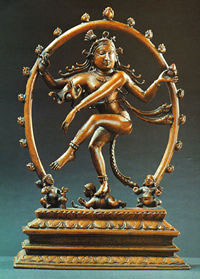Nataraja
or the Dance of Shiva.

Shiva is also known as Nataraj, the Lord of Dancers. The most splendid representations of Nataraj are to be found in the Chola bronzes from South India, from around the 8th century to the 12th century; it is the image of Nataraj which is installed as the central deity in the great temple at Chidambaram in Tamil Nadu. The image of Shiva as Nataraj is indelibly stitched into the Indian imagination. “How many various dances of Shiva are known to His worshippers”, says Ananda Coomaraswamy, “I cannot say. No doubt the root idea behind all of these dances is more or less one and the same, the manifestation of primal rhythmic energy.” Continues Coomaraswamy, “Whatever the origins of Shiva’s dance, it became in time the clearest image of the activity of God which any art or religion can boast of.”

The dance of Shiva represents his five activities: Shrishti (creation, evolution); Sthiti (preservation, support); Samhara (destruction, evolution); Tirobhava (illusion); and Anugraha (release, emancipation, grace). The symbolic significance of every aspect of the representation of Shiva is furnished by many texts, such as the Chidambara Mummani Kovai: “O my Lord, Thy hand holding the sacred drum has made and ordered the heavens and earth and other worlds and innumerable souls. Thy lifted hand protects both the conscious and unconscious order of thy creation. All these worlds are transformed by Thy hand bearing fire. Thy sacred foot, planted on the ground, gives an abode to the tired soul struggling in the toils of causality. It is Thy lifted foot that grants eternal bliss to those that approach Thee. These Five-Actions are indeed Thy Handiwork.”
– Source: “The Dance of Shiva”, in Ananda K. Coomaraswamy, The Dance of Shiva: Fourteen Indian Essays, rev. ed. (New York: Noonday Press, 1957), 66-78.





